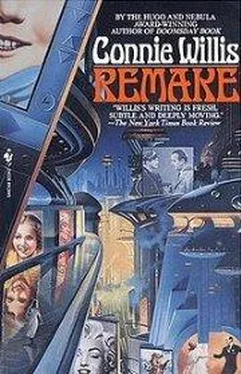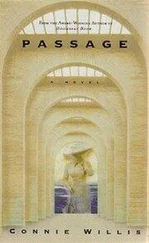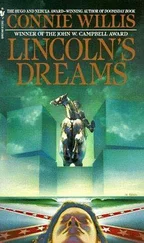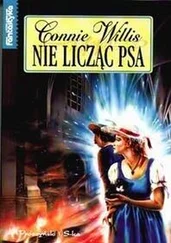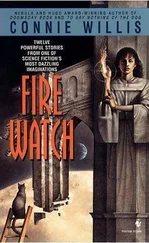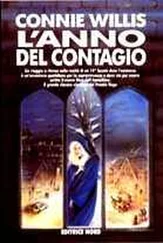It wasn’t in litigation. But her nemesis, Gene Kelly, was in it, leaping around in a white sailor suit and making it look hard. “Next, please,” I said, and Ann Miller appeared in a low-cut dress, apple cheeks, and Marilyn figure, tapping her way between dinosaur skeletons. Even with makeup and digital padding, Alis couldn’t have been mistaken for her, and I had the feeling that was important, but the clatter of Ann’s taps was making my head pound. I “next, please” ’d to the Meadowville number Alis had said she liked, Vera-Ellen and the overenergetic Gene Kelly in a softshoe. Vera-Ellen was a lot more Alis’s size, she even had a hair ribbon, but she wasn’t Alis either. “Next, please.”
Gene Kelly did one of his overblown ballets, Frank Sinatra and Betty Garrett danced a tango with an Empire State Building telescope, and Ann Miller, in an even more low-cut dress, showed up, and then Vera-Ellen. Wearing the green weskit and black skirt Alis had worn to the party that first night. I sat up.
Vera-Ellen took Gene Kelly’s hand and spun away from the camera. “Freeze,” I said. “Enhance,” and there was no mistaking that backlit hair, and sure enough, when she spun back out of the turn, it was Alis, reaching her hand out, smiling delightedly at Gene.
I asked for a menu of Vera-Ellen movies. “ Belle of New York,” I said.
Legalese. Fred Astaire. Ditto Three Little Words. I finally got The Kid from Brooklyn, and went through it number by number, but Alis wasn’t in it, and there must be some other logic at work here. What? Gene Kelly? He’d been in both Singin’ in the Rain and On the Town.
“Anchors Aweigh,” I said.
Gene’s costars were Kathryn Grayson and Jose Iturbi, neither of whom were noted for their dancing ability, so I didn’t expect there to be any production numbers. There weren’t. Gene Kelly danced with Frank Sinatra, with a chorus line of sailors, with a cartoon mouse.
It was another of his overblown fantasy numbers, this time with an animated background and Tom and Jerry and a lot of pre-CG special effects, but he and Tom the Mouse danced a soft-shoe side by side, hand and paw nearly touching, and it almost looked like the real thing.
I accessed Vincent, decided I didn’t want this on the feed, and punched in a key override, wishing there was a way I could find out whether Heada was standing guard without opening the door.
There wasn’t, but it was okay. She wasn’t there. I locked the door in case she came back, and went down to the party. Vincent was demonstrating a new program to a trio of breathless Marilyns.
“Give it a command,” Vincent said, pointing at the screen, where Clint Eastwood, dressed in a striped poncho and a concho-banded hat, was sitting in a chair, his hands at his sides like a puppet’s. “Go ahead.”
The Marilyns giggled. “Stand,” one of them said daringly. Clint got woodenly to his feet.
“Take two steps backward,” another Marilyn said. “Mother, may I?” I said. “Vincent, I need to talk to you.” I got between him and the Marilyns. “I need to bluescreen some liveaction into a scene. How do I do that?”
“It’s easier to do a scratch construct,” he said, looking at the screen where Clint was standing, waiting for orders. “Or a paste-up. What kind of liveaction? Human?”
“Yeah, human,” I said, “but a paste-up won’t work. So how do I bluescreen it in?”
He shrugged. “Set up a pixar and compositor. Maybe an old Digimatte, if you can find one. The tourate traps use them sometimes. The hard part’s the patching — lights, perspective, camera angles, edges.”
I’d stopped listening. The A Star Is Born place down on Hollywood Boulevard had had a Digimatte. And Heada’d said Alis had gotten a job down there.
“It still won’t be as good as a graphic,” he was saying. “But if you’ve got an expert melder, it’s possible.”
And a pixar, and the comp know-how, and the accesses. None of which Alis had. “What if you didn’t have accesses? Say you wanted to do it without anyone knowing about it?”
“I thought you had full studio access,” he said, suddenly interested. “Did Mayer fire you?”
“This is for Mayer. I’m taking the AS’s out of a hackate movie,” I said glibly. “ Rising Sun. There are too many visual references to do a wipe. I’ve got to do a whole new scene, and I want it to be authentic.” I was counting on his not having seen the movie, or knowing it was made before accesses, a good bet with somebody who’d turn Clint Eastwood into a marionette. “The hero superimposes a fake image over a real one. To catch a criminal.”
He was frowning vaguely. “Somebody breaks into the fibe-op feed in this movie?”
“Yeah,” I said. “So how do I make it look like the real thing?”
“Source piracy? You don’t,” he said. “You have to have studio access.”
Nowhere fast. “I don’t have to show anything illegal,” I said, “just talk about how he finds a bypass around the encryptions or breaks into the authorization guards,” but he was already shaking his head.
“It doesn’t work like that,” he said. “The studios have paid too much for their properties and actors to let source piracy happen, and encryptions, authorization guards, navajos, all those can be gotten around. That’s why they went to the fibe-op loop. What goes out comes back in.”
Up on the screen Clint had started moving. I glanced up. He was walking in a figure-eight pattern, hands down, head down. Looping.
“The fibe-op feed sends the signal out and back again in a continuous loop. It’s got an ID-lock built in. The lock matches the signal coming in against the one that went out, and if they don’t match, it rejects the incoming and substitutes the old one.”
“Every frame?” I said, thinking maybe the lock only checked every five minutes, enough time to squeeze in a dance routine.
“Every frame.”
“Doesn’t that take a ton of memory? A pixel-by-pixel match?”
“Brownian check,” he said, but that wasn’t much better. The lock would check random pixels and see if they matched, and there’d be no way to know in advance which ones. The only thing you’d be able to change the image to was another one exactly like it.
“What about when you have accesses?” I said, watching Clint make the circuit, around and around. Boris Karloff in Frankenstein.
“In that case, the lock checks the altered image for authorization and then allows it past.”
“And there’s no way to get a fake access?” I said.
He was looking at the screen irritatedly, as if I was the one who’d set Frankenstein in motion. “Sit,” he said. Clint sat.
“Stay,” I said.
Vincent glared at me. “What movie did you say this was for?”
“A remake,” I said, looking over at the door. Heada was coming in. “Maybe I’ll just stay with the wipe,” I said, and ducked off toward the stairs.
“I still don’t see why you insist on doing it by hand,” he called after me. “There’s no point. I’ve got a search-and-destroy program—”
I skidded upstairs and punched in the override, cursing myself for locking the door in the first place, opened it, got in bed, remembered the door was supposed to be locked, locked it, and flung myself back on the bed.
Hurrying had not been a good idea. My head had started to pound like the drums in the Latin number in Tea for Two.
I closed my eyes and waited for Heada, but it must not have been her in the doorway, or else she had gotten waylaid by Vincent and his dancing dolls. I called up Three Sailors and a Girl, but all the “next, please” ’s made me faintly seasick. I closed my eyes, waiting for the queasiness to pass, and then opened them again and tried to come up with a theory that didn’t belong in a movie.
Читать дальше
